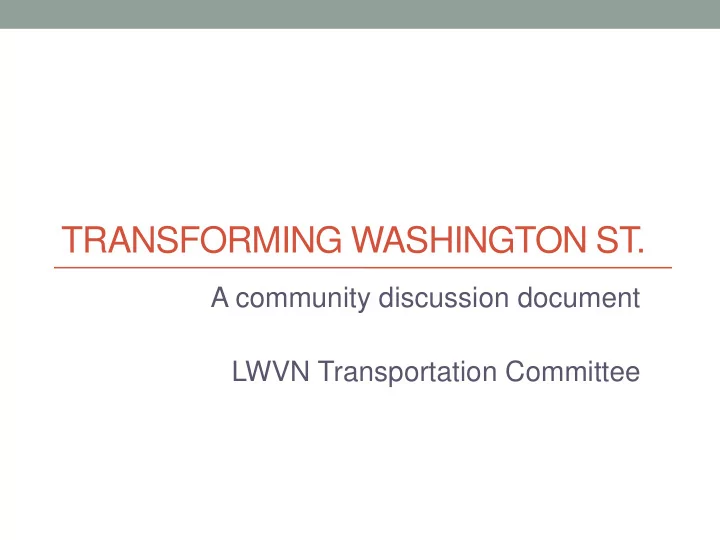

TRANSFORMING WASHINGTON ST. A community discussion document LWVN Transportation Committee
Comprehensive Plan “The vision of the city we seek includes pedestrian-friendly streets that connect neighborhoods and that work to enhance public transit, that in turn connects clusters of activity. In that vision, traffic calming and streetscape improvements encourage pedestrian-friendly, vital urban and residential environments. Mobility for all is enhanced for both auto and non-auto modes, and that is accomplished through changes that are consistent with community character and historic resources. A full range of travel modes is supported, including walking, cycling, carpooling and taking transit, among them reducing reliance on auto driving” Newton Comprehensive Plan 2007
Comprehensive Plan In pursuing that vision we have two major goals for Newton: • To Enhance and Promote Equity in Mobility Our intention is to promote accessibility for all residents of Newton in all parts of the City, including the 30% of the population that does not drive. • To Maintain City Character and Quality of Life Our intention is to assure that transportation change promotes rather than degrades the kind of City that is being sought, enhancing Newton’s village centers, neighborhoods, and other areas. Newton Comprehensive Plan 2007
Why now? • Increasing interest in active transportation, reducing congestion, becoming more sustainable • Next generation of Newtonites as well as aging Newtonites want to live car-free or car-light • Mitigate traffic effects from additional housing and businesses along corridor with transportation mode shift • Economic opportunity from improving walkability, bikeability, neighborhood feel
Washington St. Corridor Studies • MPO/MAPC completed in 2014 studied from West Newton to Newton Corner. http://www.ctps.org/data/html/studies/highway/2015_wash ington_subregional/washington_subregional_priority.html • WPI completed a study in 2011 from Commonwealth Ave. through West Newton Square http://bikenewton.org/wp- content/uploads/2012/07/Washington-Street-complete- street.pdf • Student Eunice Kim developed a plan in 2009 for bike lanes from Chestnut St. to Lowell Ave http://bikenewton.org/files/Washington-St.pdf
Safety Concerns Higher than average crash rate for all users (vehicle, pedestrian and bicycle) • High travel speeds and unsafe conditions for all users due to multiple-lane traffic operations and wide lanes, roadway design • Unsafe pedestrian crossings due to large roadway surface widths and high travel speeds, including access to bus stops • Lack of separate or safe bicycle accommodations • Narrow and unpaved sidewalks along the south side of the street • Insufficient lighting • Limited sight distances to Washington Street from side streets due to roadway geometry and parking at street corners
Other Concerns • Noise from I-90 is an issue for the residents • Residents disfavor high travel speeds that are encouraged by roadway design • Inconvenient and unsafe access from Washington Street to adjacent businesses and residences • Lack of trees, separation from the roadway • Washington St. resembles highway more than village street • Washington St. currently has excess capacity that may become filled
Potential Washington St. Priorities • Sidewalk network on both sides of street • Separated bike lanes • Safer crossings at intersections • Safe midblock crossings where needed for bus access or other facilities • Slow traffic to village center street speed 30 mph • Screening of I-90, reducing ambient noise • Street trees, benches
Western Avenue, Cambridge
Western Avenue, Cambridge
Western Avenue, Cambridge
Ames St. Cambridge
Safe Bike Crossings
Bus stops and bike lanes
Two way cycle track
Example of typical cross section
Protecting the bike lanes with parking
How can we make this even better?
What if we did this?
What if we designed better bus stops?
Reduce conflicts bus stops & bike lane
Recommend
More recommend